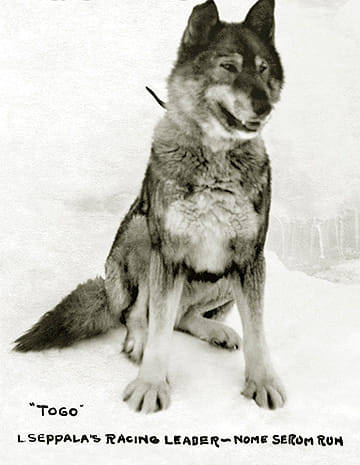Text
Togo, the REAL hero of the Nome Diptherea Serum Run

Togo was ill as a young puppy and required intensive nursing from Seppala's wife. He was very bold and rowdy, thus seen as "difficult and mischievous", showing "all the signs of becoming a ... canine delinquent" according to one reporter. At first, this behaviour was interpreted as evidence that he had been spoiled by the individual attention given to him during his illness. As he did not seem suited to be a sled dog, Seppala gave him away to be a pet dog at 6 months of age. After only a few weeks as a house pet, Togo jumped through the glass of a closed window and ran several miles back to his original master's kennel. This devotion to the team impressed Seppala, so he did not try to give him away again. However, Togo continued to cause trouble by breaking out of the kennel when Seppala took the team out on runs. He would attack the lead dogs of oncoming teams, "as if ... to clear the way for his master". However, one day, he attacked a much stockier malamute leader and was mauled and severely injured. When he recovered, Togo stopped attacking other teams' lead dogs. This would eventually prove a valuable early experience, as it was difficult to teach a lead dog to keep a wide berth of oncoming teams. When Togo was 8 months old, he proved his worth as a sled dog. He had run after the team yet again and slept, unnoticed, near the cabin where Seppala was spending the night. The next day, Seppala spotted him far off in the distance, and understood why his dogs had been so keyed up. Togo continued to make Seppala's work difficult, trying to play with the work dogs and leading them in "charges against reindeer", pulling them off the trail. Seppala had no choice but to put him in a harness to control him, and was surprised that Togo instantly settled down. As the run wore on, Seppala kept moving Togo up the line until, at the end of the day, he was sharing the lead position with the lead dog (named "Russky"). Togo had logged 75 miles on his first day in harness, which was unheard of for an inexperienced young sled dog, especially a puppy. Seppala called him an "infant prodigy", and later added that "I had found a natural-born leader, something I had tried for years to breed" Togo began training, and after a few years filled the lead dog position. He became one of Seppala's most treasured dogs, a close and mutually beneficial relationship that would continue to the end of Togo's life. At the time of the historic Serum Run, he was 12 years old and had been a lead dog for 7 years. According to the historian Earl Aversano, in 1960, in his old age, Seppala recalled "I never had a better dog than Togo. His stamina, loyalty and intelligence could not be improved upon. Togo was the best dog that ever traveled the Alaska trail. "The first batch of 300,240 units of serum was delivered by train from Anchorage to Nenana, Alaska, where it was picked up by the first of twenty mushers and more than 100 dogs who relayed the serum a total of 674 miles (1,085 km) to Nome, Togo and Seppala traveled 170 miles (274 km) from Nome in three days, and picked up the serum in Shaktoolik on January 31 - The temperature was estimated at −30 °F (−34 °C), and the gale force winds causing a wind chill of −85 °F (−65 °C). The return trip crossed the exposed open ice of the Norton Sound. The night and a ground blizzard prevented Seppala from being able to see the path but Togo navigated to the roadhouse at Isaac's Point on the shore by 8 PM preventing certain death to his team. After traveling 84 miles (134 km) in one day, the team slept for six hours before continuing at 2 AM. Before the night the temperature dropped to −40 °F (−40 °C), and the wind increased to 65 mi/h (105 km/h). The team ran across the ice, which was breaking up, while following the shoreline. They returned to shore to cross Little McKinley Mountain, climbing 5,000 feet (1,500 m). After descending to the next roadhouse in Golovin, Seppala passed the serum to Charlie Olsen, who in turn would pass it to Gunnar Kaasen and Balto. Katy Steinmetz in Time Magazine wrote that “the dog that often gets credit for eventually saving the town is Balto, but he just happened to run the last, 55-mile leg in the race. The sled dog who did the lion's share of the work was Togo. His journey, fraught with white-out storms, was the longest by 200 miles and included a traverse across perilous Norton Sound — where he saved his team and driver in a courageous swim through ice floes."
Credit: Laura Mathews
#Togo the sled dog#Balto the sled dog#ididerod origin#nome diptheria serum run#savior of nome's children#the goodest boy#look at those PAWS#and that's why working dog handlers look for the troublemakers#the BEST boy
43 notes
·
View notes